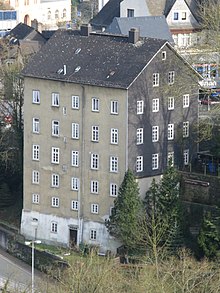Wilhelm Jacob Wimpf
Wilhelm Jacob Wimpf (born November 15, 1767 in Weilburg ; † April 11, 1839 there ) was a Nassau-Weilburg civil servant and entrepreneur. He pioneered the tamped earth building (Pisébau) in Germany.
Life
Wilhelm Jakob Wimpfs was the son of Johann Matthias Wimpf and Margarete Wimpf née Medicus. His father was born in Nördlingen and has been serving in Nassau-Weilburg since 1748. His mother came from a respected family of officials from Weilburg. Wilhelm Jakob Wimpf was married to Maria Sybillee Schnerr from Kirchberg an der Jagst .
Wilhelm Jakob Wimpf attended the Weilburger grammar school Philippinum and then studied law at the universities of Giessen and Göttingen . He did his doctorate in Göttingen.
In 1789 he was employed as a government advocate for the Princely Nassau-Weilburg government. In 1792 and 1796 he was responsible for negotiating the contribution payment with the French occupation troops in the first coalition war . Wimpf made a name for himself with his skillful negotiation. He negotiated the French Army's demand from 200,000 guilders to 150,000 guilders .
In 1799 Wilhelm Jakob Wimpf ended his civil service career and took over the inheritance of the ailing Weilburg paper mill on the Guntersau. Within a few years, Wimpf managed to convert the mill into a flourishing business. He then bought the surrounding land and had other businesses built. First a stoneware factory was built , then a flour mill . However, he was only able to put this into operation after he had taken the Müller test as an autodidact.
After long negotiations, he finally succeeded in acquiring the paper mill's inheritance in 1832. He had linked his new operations with the old one in such a way that separation was no longer possible. When he died, the company premises included the paper mill, a brandy distillery , the stoneware factory with a gypsum mill and two glaze mills , the fruit mill, a greenhouse, a lithographic printing plant and numerous outbuildings.
Wimpf also developed activities outside of Weilburg. He bought the oil mill in Ahausen , became a partner in Löhnberger Mühle and had the clay pit Wimpfsfeld in Mengerskirchen developed. He also acquired stakes in iron and lignite mines.
From 1826 to 1828, Wimpf also built the house at Hainallee 1 as a residence for his family. This house is still considered to be the tallest rammed earth building in the world. For his extensive construction work, Wimpf resorted to rammed earth construction. This construction method was made famous in France by Franz Cointeraux . His book "Schule der Landbaukunst" was translated into German in 1793.
Wimpf acquired the necessary specialist knowledge self-taught . In 1836 he wrote his experiences in the book “The Pisé-Bau or complete instructions to build extremely cheap, permanent, warm and fireproof dwellings from bare earth, called Pisé-Bau.” In his foreword, Wimpf wrote: “The author, the Has occupied himself with this useful construction for 36 years, has large factory buildings 200 and more feet in length, of relative depth, three- and four-story, others of 100, 60 and 50 feet in which there are raging water-mills, which make more tumult and vibrations than much ever takes place in a house and in which the storerooms, besides the heavy load in the rooms, carry hundreds of hundred pounds of fruit, hay and straw, and other heavy objects, without even one of these buildings, which are more than 1000 feet in front, in his The inside would have changed in the least in its outside. ”The first edition of this book and the lithographed plates were made in Wimpf's printing works in Weilburg igt. A copy of the second edition is in the Moscow State Library .
In this construction technique, Wimpf rose to become a sought-after expert. He advised Christian Zais on the construction of the Gassenbacher Hof's economic building in Idstein in 1811/12. This building housed the Agricultural Institute of the Duchy of Nassau . He also advised the Nassau government on the Pisé model buildings erected in the Montabaur office .
Several craftsmen learned the construction technology of the Pisé building at Wimpf. Numerous residential and commercial buildings were built by them as Pisé buildings in Weilburg. This made Weilburg a center of Pisé building technology. Many of these houses are still in Weilburg today. Especially on Limburgerstrasse, Bahnhofstrasse and Frankfurter Strasse. Where they shape the cityscape.
Literature from Wilhelm Jakob Wimpf
- The Pisé-Bau or complete instructions to build extremely cheap, permanent, warm and fireproof dwellings from bare rammed earth, called Pisé-Bau . 1st edition: Lanz, Weilburg 1837; 2nd edition: Class, Heilbronn 1841; Reprint of the 2nd edition in: Wilhelm Schick: The Pisé building in Weilburg an der Lahn . Citizens' initiative "Alt-Weilburg", Weilburg an d. Lahn 1987.
- Via belt and cap vaults in connection with the Pisé building . Class, Heilbronn / Lanz, Weilburg (on commission) 1838.
literature
- Wilhelm Schick: The Pisé building in Weilburg an der Lahn . Bürgerinitiative Alt-Weilburg eV, Weilburg 1987. Without ISBN.
Web links
Individual evidence
- ^ A b c Manfred Horz: "Skyscraper" made of clay . In: Nassauische Neue Presse . January 7, 2016, p. 14 .
- ^ Falko Lehmann: Cultural monuments in Hessen: Limburg-Weilburg district. Volume 2: Mengerskirchen to Weinbach. Published by the State Office for the Preservation of Monuments in Hesse . Vieweg Verlag , Wiesbaden 1994. ISBN 3-528-06243-6
- ^ Text based on: Wilhelm Schick: The Pisé building in Weilburg an der Lahn, page 18
| personal data | |
|---|---|
| SURNAME | Wimpf, Jacob Wilhelm |
| ALTERNATIVE NAMES | Wimpf, Jakob Wilhelm |
| BRIEF DESCRIPTION | Nassau civil servant and entrepreneur, pioneer of earth building |
| DATE OF BIRTH | November 15, 1767 |
| PLACE OF BIRTH | Weilburg |
| DATE OF DEATH | April 11, 1839 |
| Place of death | Weilburg |
